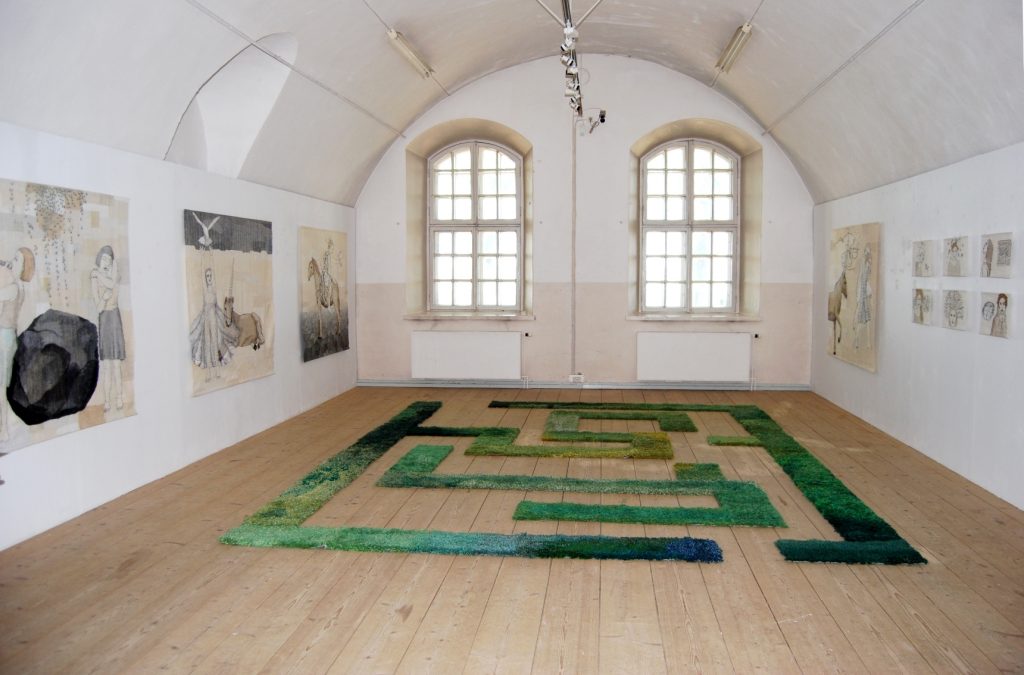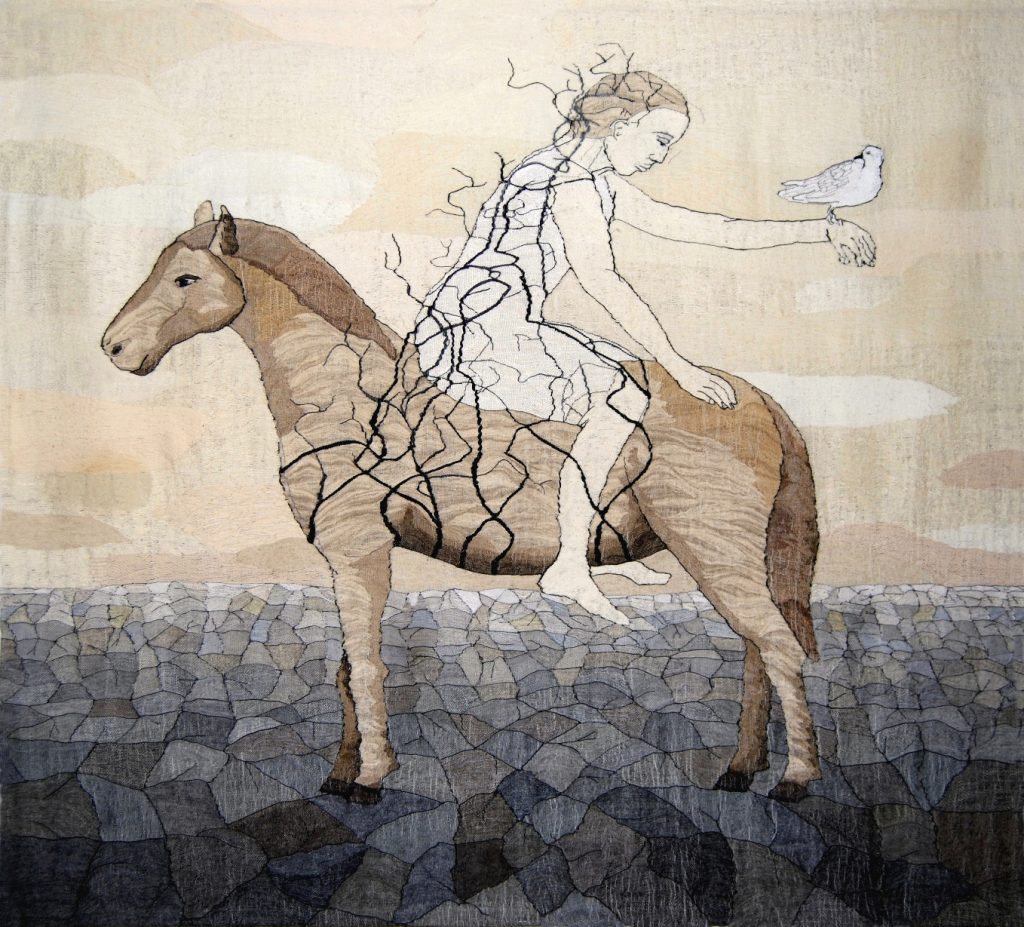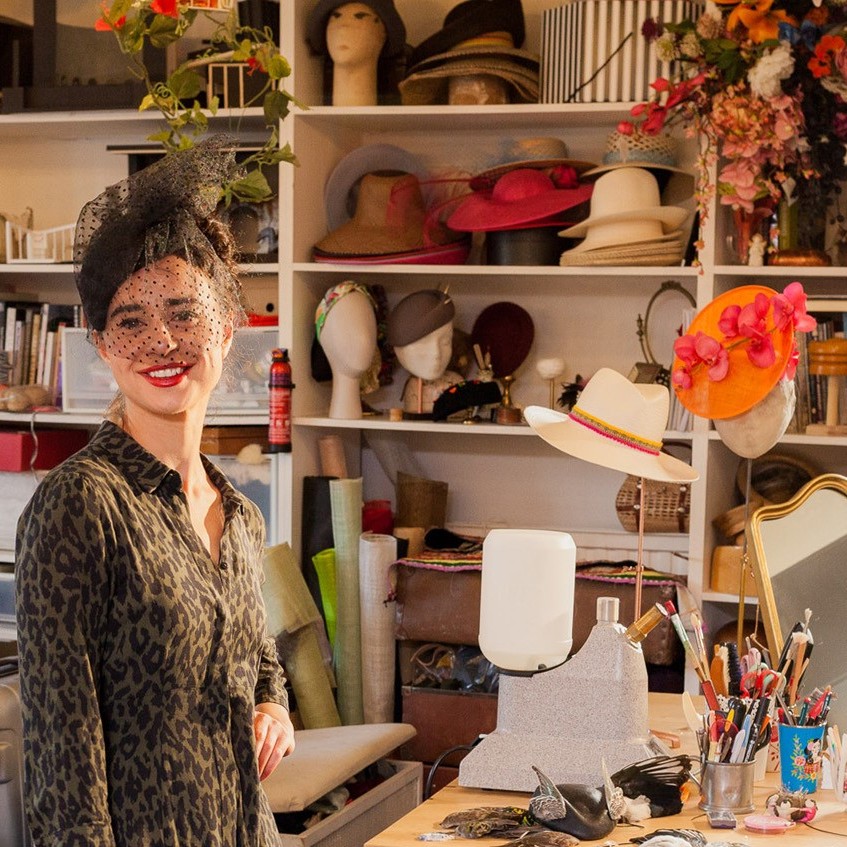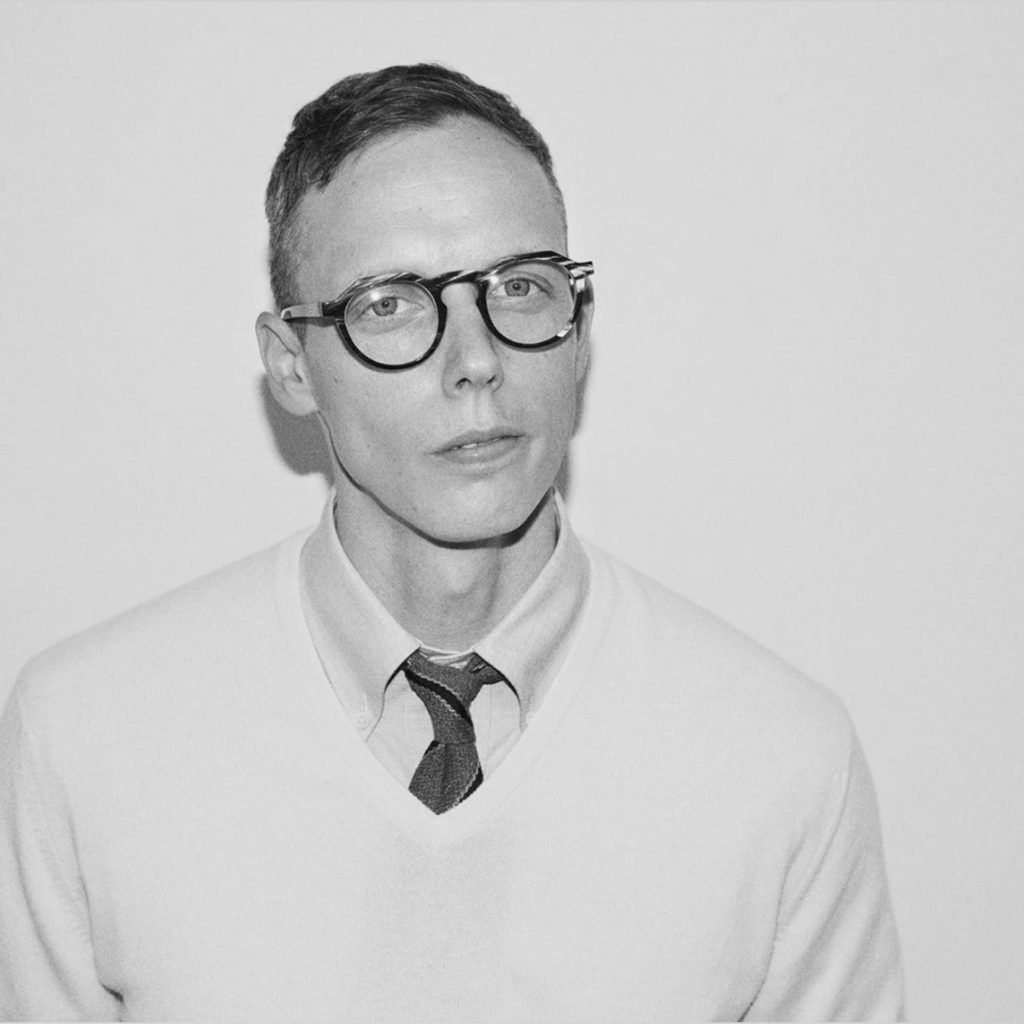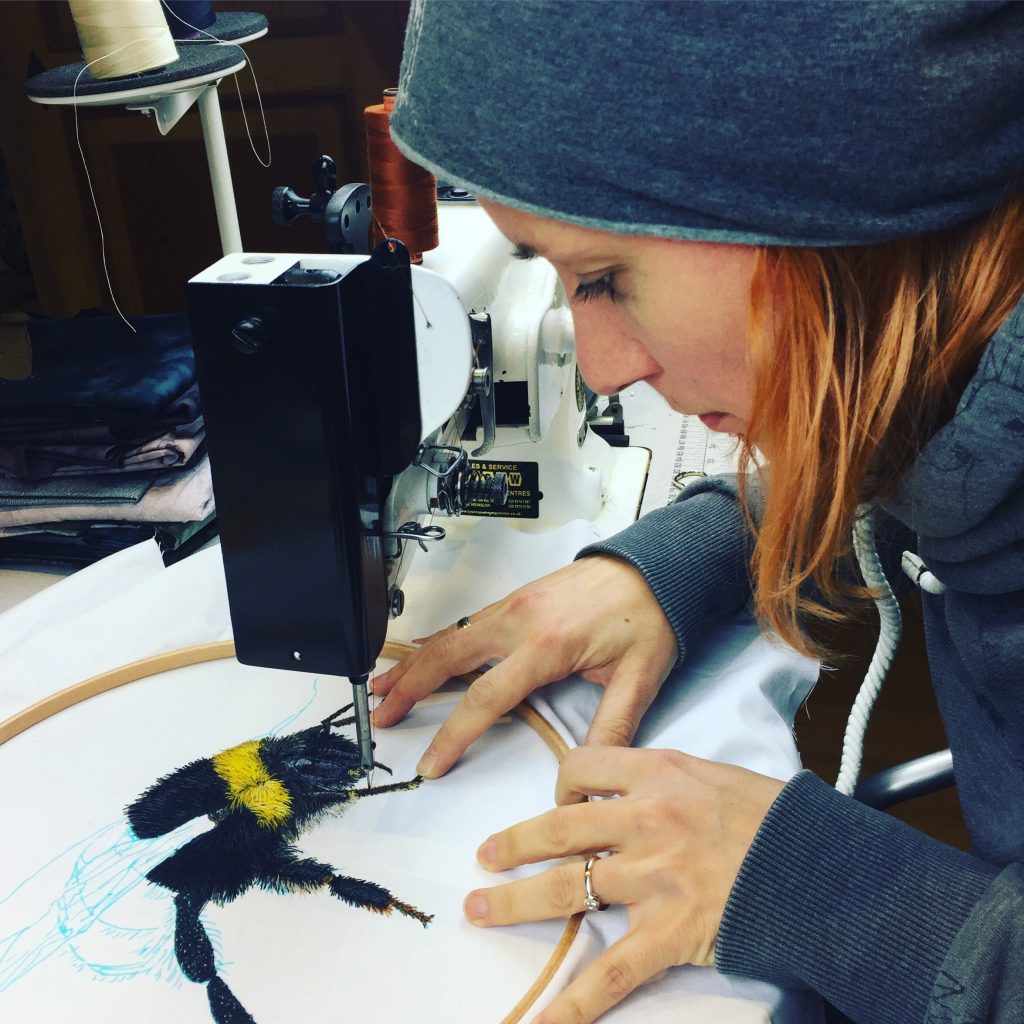Aino Kajaniemi Textile Artist
How do you portray ‘moments and atmospheres in a persons life’ onto fabric?
I see my art as symbols. In my tapestries I combine human beings and symbols together. The symbols can be animals, plants or an object such as clothing. They are personal, intimate objects which portray our similar common memory. My symbolist picture language is like international communication without words.
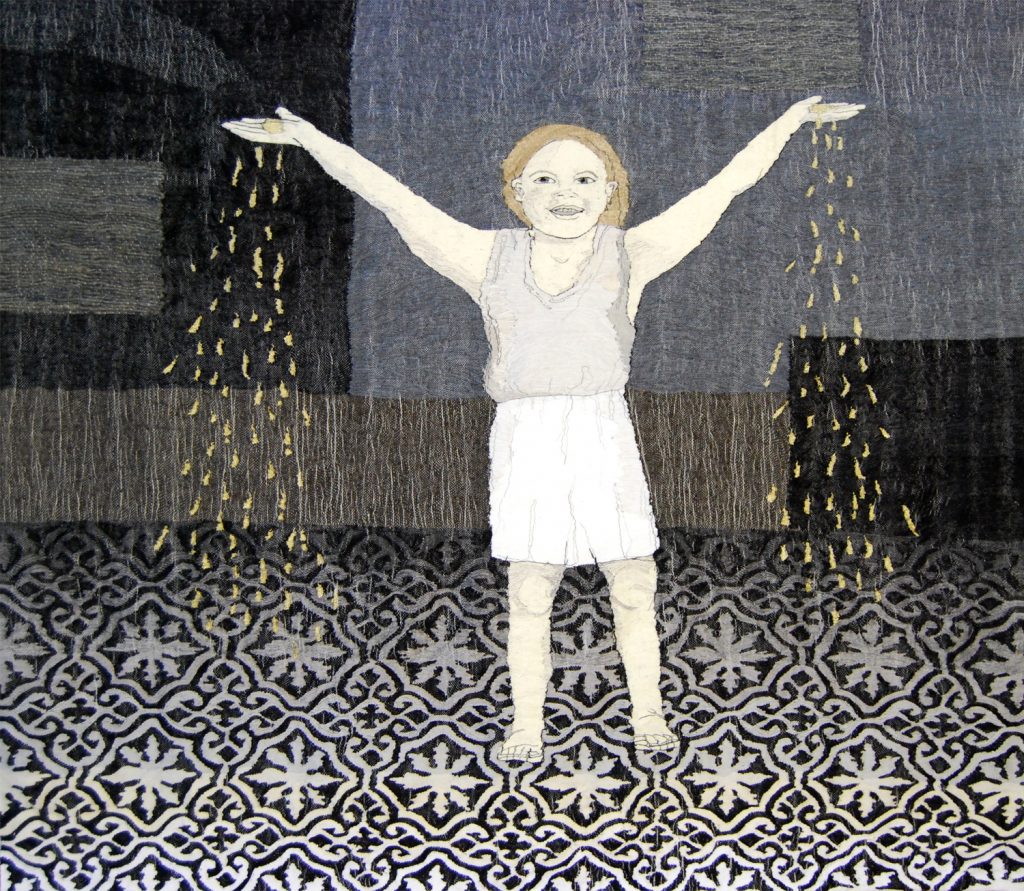
Golden Rain
There is something about the posture or facial expression of a human in relation to his or her environment that can create a memory or an association in my mind to something I have experienced; lives concrete feelings, moments and atmospheres.
Using, ‘Poppies’ and ‘Flora’, explain the differences but also the connections between these pieces.
Poppies series is a colour study. I have used colours from the warm pallet but added their contrast colours as lines and shadows in the flower. I tried to create an impression of joy and energy.
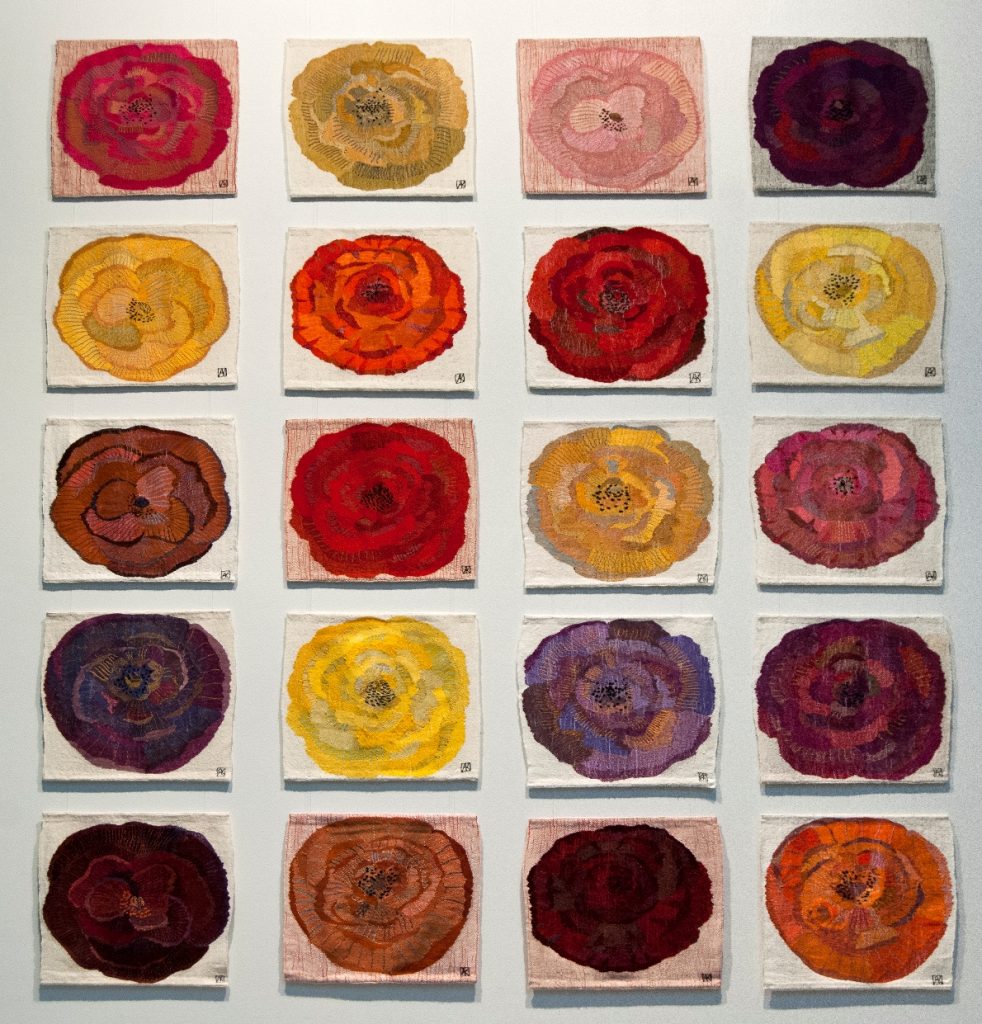
Poppies
In the Flora series the black background is very important. The plants have the main role: form, fragility, character and tones
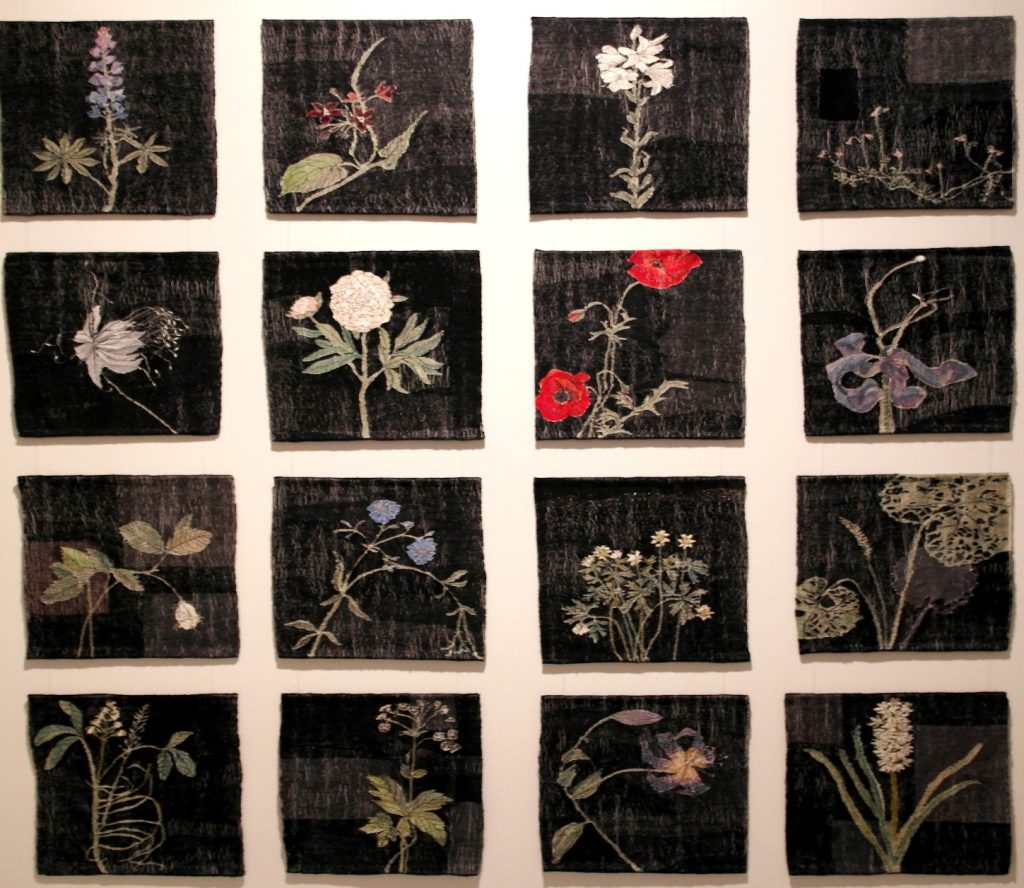
Flora
You use tone and a limited palette in your works ‘Beauty’ and ‘Innocent’. Discuss this whole series and how it came about and the need for such a subtle palette.
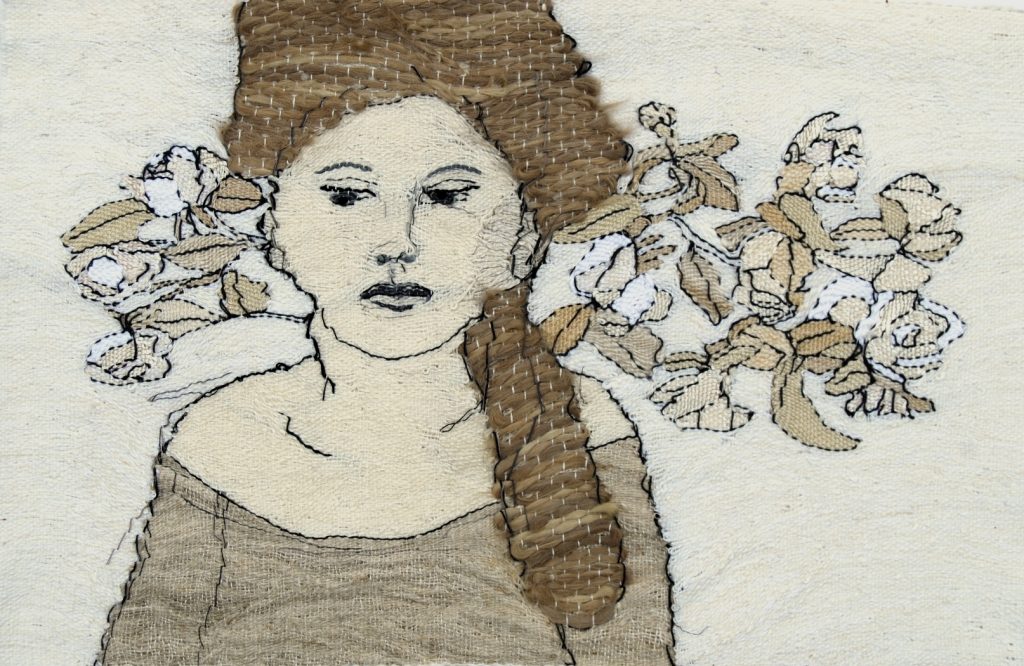
Beauty
When I was young I had lot of feelings that I held inside me. I spent all my energy to work out my emotional life so I didn’t want to have more feelings to handle through colors. The black and white world seemed simpler. I want to use shades more than colours. I feel that colours need a bigger space because they are full of energy. When I use strong colours I don’t want to tell a story in the work. Colour in itself includes messages.
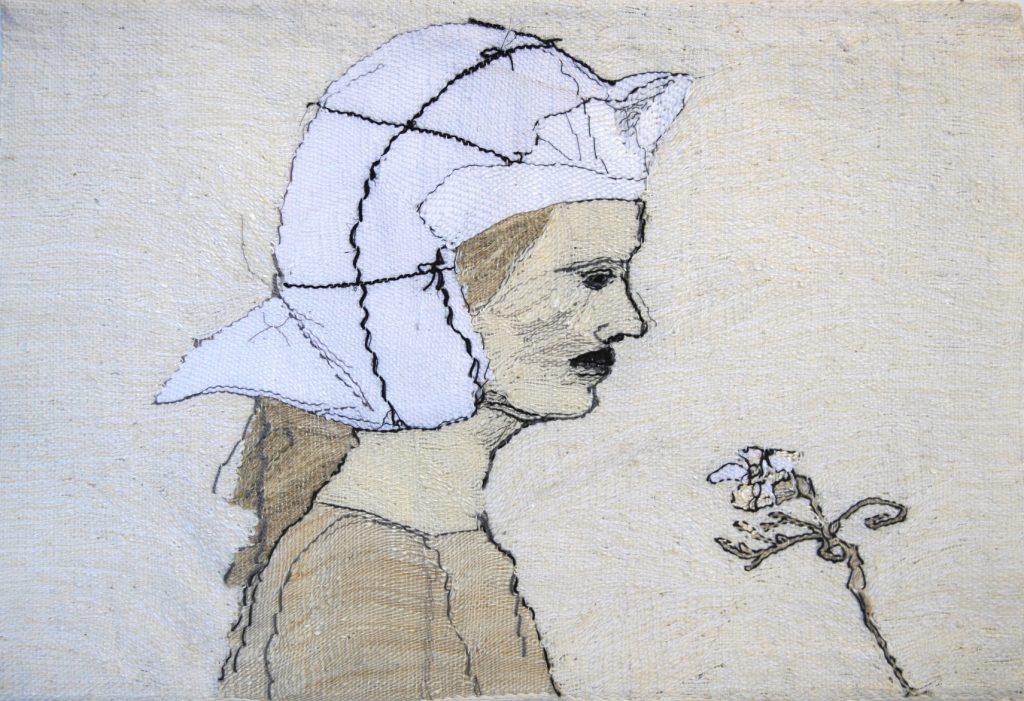
Innocent
Comment on the techniques you in different hair and floral aspects in your work.
My tapestries are very graphic. Drawing with a pencil I have an idea of a certain kind of a line. As a contrast of the fine line I like to add rough materials like real human hair. I like rough and smooth materials, the disagreement and discussion between them.
Various plants can be symbols of life´s complexity and alternatives, discussing with their surroundings and the environment.
You have had several Church commissions. Take one that has given you a great deal of artistic scope.
The last Church textile commission I have done is Muurame Church. It was designed by the most famous Finnish architecture Alvar Aalto in the year 1929.
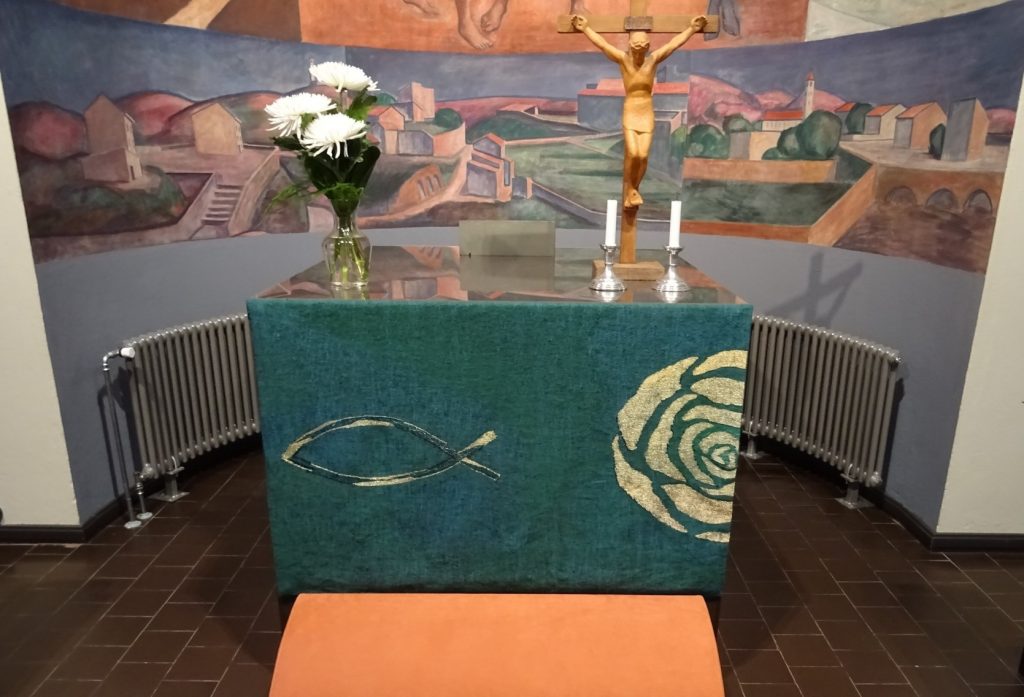
Alta Textile, Muurame Church
What was the initial brief.
The primary role of Liturgical textiles is to be a part of divine worship with metaphors communicating the Church’s message. On the other hand they also have a clear function as the priest dress and Communion textiles. At the same time textiles “decorate”, they are a part of the architecture of the church. In other words, church textiles are at the same time informational, utility articles and interior decorations. In addition to all this, they should also be independent works of art.
In Evangelic Lutheran church we use 5 or 6 colors in church textiles: White, red, green, violet, black and sometimes blue. I have done liturgical textiles for 7 churches. The colour of the textiles tells the time of the religious church year.
What is the meaning or symbolism within the piece.
The main symbol in Muurame Church´s textiles is a rose. Different colours of the flower has a different meaning: love, purity, death, virginity, perfection.
A root, leaf and stem have many liturgical meanings. A fish is the symbol of the Christ.
The relationship between the tapestry and the space it is in.
Muurame Church was renovated to its original design in the year 2018. I tried to make modern, interesting and surprising but peaceful textiles which are in a balance with the architecture of Alvar Aalto and the strong colours of the interior.
What are your personal thoughts on the importance of contemporary textiles within churches?
I like the richness of religious symbols and try to use them as much as possible. In the church they handle the most important issues: birth, life, death, faith, truth, grace, holiness and love. If the artist succeeds to get this spirit into the textiles, it is art.
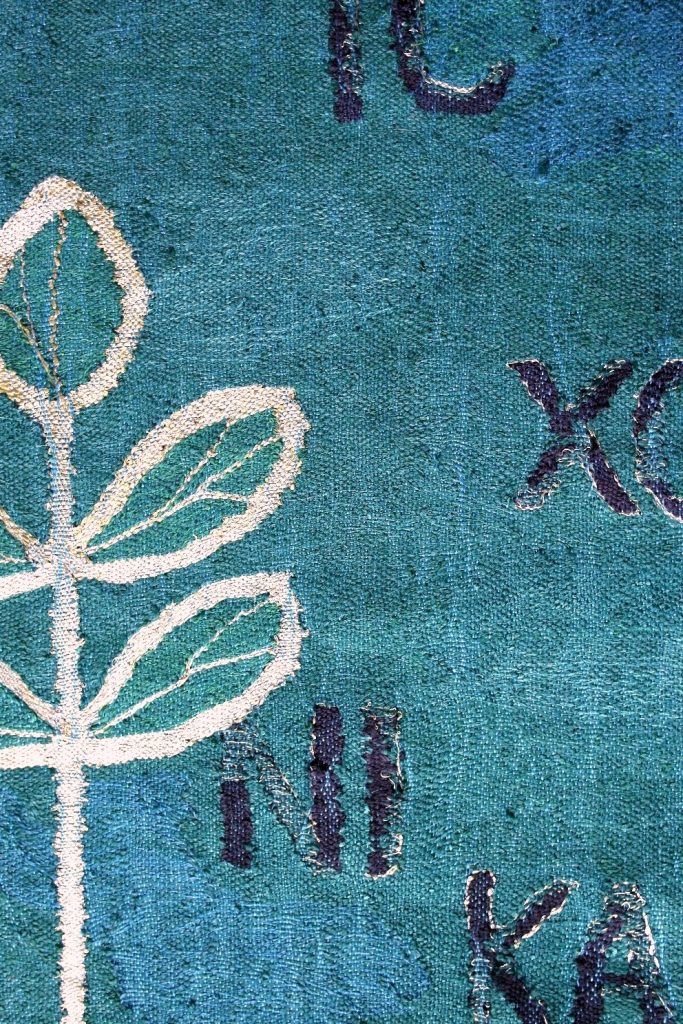
Pulput Textile
Your exhibition at the Helsinki Gallery Katariina, was big but solo. How did you manage this exhibition?
Scale, 60 square meters
Number of pieces needed, 21 pieces
The curation of the exhibition.
The gallery chooses from the applicants those who will have the gallery to exhibit their work.
I have had two big exhibitions with my daughter in the years 2017 and 2019 in big museums, Kemi and Kouvola. This has been both a challenge and a possibility. These museums are 800 and more than 1000 square meters big. My daughter, Aura Kajaniemi
makes spatial and two dimensional art works with bead embroidery.
You also portray animals in some of your work. Discuss one or two of the animals you have used and why?
In year 2012 I stayed in Paris for 2 months. My idea was to get to know the world´s maybe most famous tapestry series, The Lady and the Unicorn and start to design my own large tapestry series influenced by the series. I combined the story with human beings in large tapestries. I made 10 big sketches. At first there was a unicorn, then the horn dropped off portraying a horse and finally no animal at all. Afterwards I have analyzed these tapestries and have found commonly handled questions: how a human being can find her/his place in the world, the reverses, fears, needing support and dreams.
Sounder
Take us briefly through the technical process from the first drawings to the final finished piece.
My work begins with drawing by a usual pencil on a paper. All my tapestries have a same-size sketch. I set it to the back of the warp and follow the pencil lines by weaving.
My weaving is not traditional tapestry weaving. I think that it can be expressed as impressionism in tapestry. I don’t know or care about rules but want to weave freely and quickly. I use vertical loom and fasten the weft with a common fork. I don’t want to hide the warp, like in a traditional tapestry because in my way of weaving the surface becomes livelier and you can see the structure of the fabric.
Weaving is about making decisions; how thick or thin threads to use, do I combine threads to form different tones or use original colors, do I want the surface to be shiny or rough, do I create structure and effects using thicker materials? Do I want the tissue to be so dense that it cloaks the warp threads or so that the texture of the tapestry stands out and the fabric becomes almost transparent?
Nowadays I get all of my weft threads from flea markets. That way surprising tones and materials appear in my color pallet. Weaving is also finding; even though I have practiced this technique almost 40 for years, I´m not in complete control of the threads. Chance has its role, for example when I weave a face, the threads may position themselves so that a smile turns into sorrow or anger becomes joy.
I like variable surfaces and use them as a part of the story of a work.

From Close to Far
The materials I have used are: linen, cotton, hemp, jute, sisal, nettle, viscose, acrylic, silk, wool, bamboo, bass, paper yarn and paper strip, horse hair and human hair, feathers, fishing line, metal wire, plastic strip and yarn, twig from a tree, birch park, lurex, gold thread and triacetate strip.
Flax is my favorite material; heckled flax in many thicknesses, tow flax, hand spun flax and even not at all worked flax fiber. In flax I can find all atmospheres from fineness to heavy burden.
Silk represents for me something luxurious and exotic, wool something homey.
Because I use an upright loom and not a frame, I use pedals so that I don´t have to pick up the leases. In my opinion this frees me to concentrate on what matters: being expressive and the choices it requires. I attach the weft to the texture with an ordinary fork.
Sometimes I feel like being a solid part of my handloom. The connection occurs in many ways; my feet pedal, eyes watch, head decides and hands interknit.
Where did you learn to become a weaver?
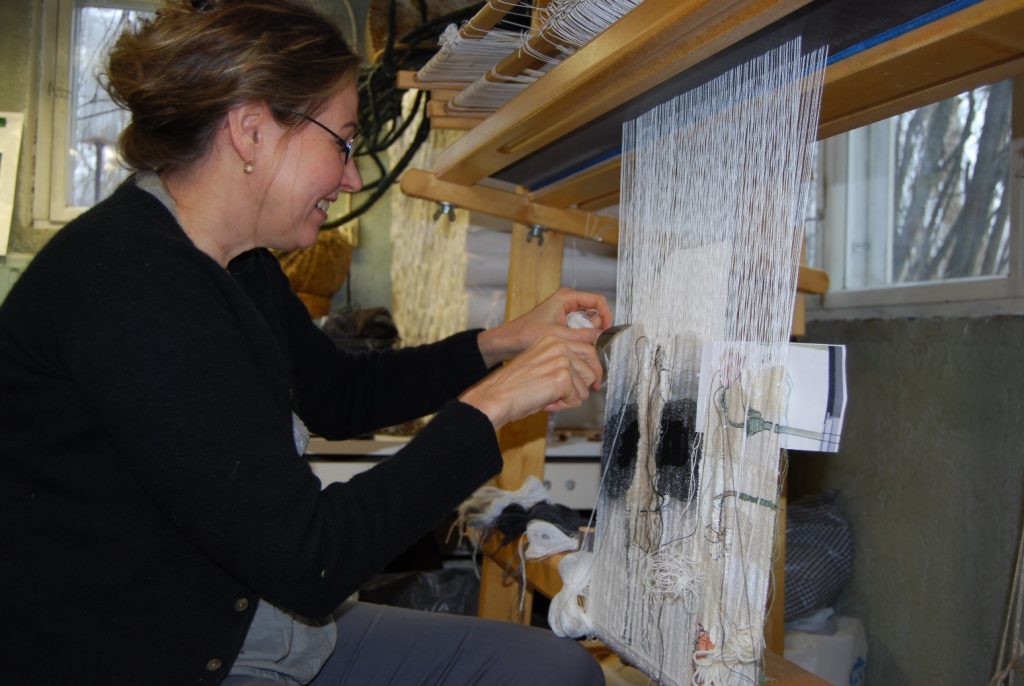
I studied first in a weaving school for two years and it was a good basis for my career. It is said that when you know the technique, you can forget it.
What lead you to tapestry as your art medium?
After weaving school I studied in the University of Art and Design in Helsinki and graduated as a textile artist in the year 1983. When I was making my final examination I showed my sketches to my teacher and she said: The only way to weave these is tapestry weaving. I had to create the weaving technique by myself; nobody really taught me how to weave a tapestry.
Discuss where your studio is.
I started to work as a free artist in 1990. The same year I moved to my childhood home to take care of my parents. My parents died and my second child was born at that same year. My family stayed in the house after my parents death. I still live and work there, in Central Finland, Jyväskylä. My weaving studio is in a base floor, drawing, sewing and office rooms at the second and the third floors.
What restrictions does your studio have or not have?
My house is designed for family life. The studio is planned for hobby and spare time working. It should be bigger and higher and there should be more storage places.
Do you think that living in Finland has influenced your need to have some artistic pursuit over the long winter days and nights?
There are many people who are very sensitive of the darkness. That isn`t my problem. I work regularly and with same daily routines all year long.
Contact details:
Aino Kajaniemi
www.elisanet.fi/aino.kajaniemi
Aino Kajaniemi, Jyväskylä, Finland
Interview by Deborah Blakeley, April 2019
Think a colleague or friend could benefit from this interview?
Knowledge is one of the biggest assets in any business. So why not forward this on to your friends and colleagues so they too can start taking advantage of the insightful information the artist has given?
Other artists you may be interested in:


